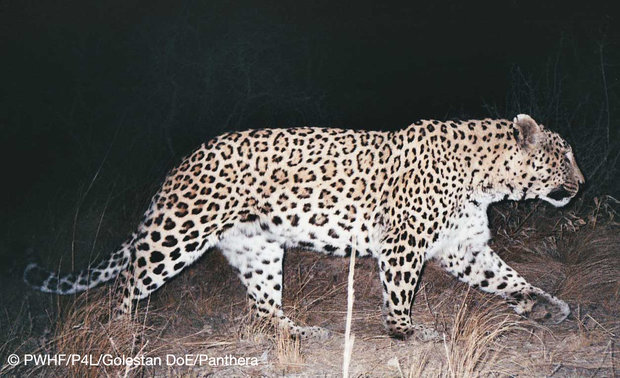Digging deep into human-carnivore conflicts in Iran

Human-carnivore conflicts is rapidly increasing in Iran. For instance just recently a young boy who was tending his sheep was attacked by a black bear on July 10, 2017 on the outskirts of a village in Jiroft, southeastern province of Kerman.
Such problems can be prevented by setting aside wildlife areas but the biggest threat by far to wildlife and human beings is the ever-increasing lack of information.
However, there are still grounds for optimism because some scientists such as Dr. Igor Khorozyan from Göttingen University in Germany and his colleagues in Iran are trying to apply some jaw-dropping methods, at least for the most important carnivore of Iran: the Persian leopard.
The conflict with leopards in Iran has escalated, resulting in extermination of leopards in many parts of their range. About two years ago, Dr. Khorozyan and his fellows worked on the relationship between climate, disease of domestic animals and human-carnivore conflicts which is still a new topic. The Tehran Times conducted an interview with Dr. Khorozyan.
Below is an excerpt of the interview:
Q: Would you please explain why precipitation of the driest quarter has been the main determinant of the existence of carnivores in humid tropical forests?
A: Iran does not have tropical forests and the western, most humid part of the Hyrcanian forest belongs to the subtropical humid broadleaf forest. Golestan National Park, where we keep on working, lies in the temperate zone. Answering your question, tropical species are adapted only to a narrow range of environmental conditions, including high precipitation and humid climate. More precipitation means denser vegetation where it’s easier to hide and there is more shadow for successful hunting. By definition, the driest quarter (e.g. summer) has minimum precipitation and least optimal vegetation conditions, so it is the most limiting factor for the survival of tropical carnivores. However, leopards are successful hunters well-adapted to live in different habitats, from semi-deserts to forests, due to their phenomenal ability to hide and stalk. For this reason, leopards depend more on their prey than on vegetation.
Q: What is the relation between bioclimatic factors and some specific livestock diseases?
A: All conflict villages near Golestan are located in the western sector of the park where humid Hyrcanian forests grow. We originally thought that these conflicts might be related to the forests because they provide excellent opportunities for leopards to hide and attack livestock from ambush. But during the questionnaire surveys, we found out that six villages located in Golestan forests do not have conflicts at all, so the cause of conflicts is probably something different, not forests. Our research has shown that livestock diseases, most commonly hoof infections, are common in humid conditions and so higher humidity leads to more diseases and morbid livestock become more vulnerable to leopard attacks. Sick individuals are very likely to straggle, or stay behind other livestock, and thus fall victim to leopards. Of course, we are at the very beginning of this investigation and much more research effort is essential to study the behavior of attacked livestock and attacking leopards, such as whether leopards select morbid livestock individuals or they take them randomly from morbid stock, and if diseases can be transferred from livestock and dogs to leopards.

Persian leopard
Q: Which diseases were considered in your survey as an indicator and why?
A: We did not study diseases directly. We just found that villages which receive less attention from veterinarian services lose more livestock. Veterinarian services are responsible for vaccinating, treating and diagnosing diseases in livestock. So, we have hypothesized that if veterinarian services do not come to villages or come seldom, then more livestock become morbid and are more likely to be killed by leopards. Yet, we do not know which diseases are primarily responsible for this, but the first candidate is the hoof infection caused by Fusobacterium necrophorum. Infected animals might be killed by leopards because they cannot move fast and keep up with the herd. Again, this is just the first step in the investigation of relationships between diseases and conflicts. A special veterinarian research is essential to develop this study.
Q: Is your method reliable to predict the probability of dangerous disease occurrences?
A: We did not develop a new approach to link diseases and human-leopard conflicts. We just applied common statistical and computer modeling techniques to local data in the Golestan NP area villages and found out the relationship. Such a study can be conducted also in other villages in Iran which have significant conflict between humans and carnivores (wolves, leopards, bears, etc.). Not only diseases, but many other factors can cause conflicts. Situations can be different from site to site.
Q: Weak prey are more desirable for carnivores but in some cases leopards kill healthy and young prey, even in cattle. Why?
A: Carnivores prefer to take prey that is easily available and profitable (giving more food and energy). That is why larger carnivores, like male leopards, may take cattle. Preferences of individual leopards can play a significant role in this, but scientists know very little about this phenomenon. For example, some leopards can be very skilled in preying on dogs while the others like to prey on sheep or calves.
Q: Why some leopards kill a large number of livestock at once?
A: This is called “surplus killing”, when a carnivore kills several livestock individuals in a single attack. This phenomenon is quite rare in leopards, but much more common in wolves, lions and snow leopards. Snow leopard is a different species living in high mountains of Central Asia, which does not live in Iran. Surplus killing occurs usually in corrals when livestock panic from a carnivore’s attack and start running without purpose in a closed space. All this awakens the carnivore’s hunting instinct. Less often, several livestock individuals can be killed by a group of mother and grown-up cubs, which demand much more food. Lions hunt in groups and also may kill multiple individuals.

Golestan National Park, photo by Igor Khorozyan
Q: Do you think the increasing rate of aridification in Golestan National Park and decreased number of wild prey will increase the number of human-leopards conflicts in the future?
A: The pattern is opposite – aridification will decrease the occurrence of conflicts. In Golestan, like in many other regions of the world, conflicts are confined to humid areas or seasons. For this reason, increasing air temperatures and declining precipitation will move depredation down. On the other hand, it is possible that in extreme cases some carnivores may learn to kill livestock around limited waterholes and thus increase depredation under arid conditions.
Q: How can these conflicts be managed? In other words, what is the responsibility of the Department of Environment (DOE) and other organizations? How can they be of any help?
A: International experience shows that the best way to cope with conflicts is to combine efforts of the government, scientists, non-governmental organizations and local people. The government alone cannot solve the problem if local people stand against it. The main problem in Golestan is that villagers do not have sufficient lands to graze their livestock, that is why they are forced to take livestock inside the national park and thus to violate the protection regime. It would be better for local people to keep livestock near their villages, where carnivores usually do not attack, but they do not have large enough pastures.
Roads, crop fields, factories and other infrastructure separate protected areas and hinder free movements of animals. Many animals die on roads from car collisions (like in Golestan) and roads also provide easy access to poachers.
Compensation of economic losses does not solve the problem of conflicts, because villagers receive money but do not improve their practices to minimize losses. It is of key importance for the DOE to limit poaching of wild prey species, especially ungulates, which are the main prey for leopards. If leopards have sufficient prey inside the park, they will not kill as much livestock as they do it now. The DOE should also improve its current methods used to count and regularly monitor ungulates in the park. The utilized method should be scientifically reliable, standardized and applicable to all ungulate species. A serious flaw is that park rangers do not accurately record wild boars, which are the main prey for leopards.
On the other hand, villagers should pay more attention to protecting their livestock from carnivores. A great majority of livestock is killed by leopards during daytime grazing, since during the night time they are safely locked in corrals in villages. That is why it is important to improve the quality of shepherds and dogs used for grazing. For example, in Golestan, cattle usually graze freely in forests without shepherds, which is the main reason for cattle getting killed by leopards in Golestan. On the other hand, sheep and goats are often (but not always) guarded, but shepherds and dogs cannot react efficiently even if they see a leopard attack. More shepherds should accompany sheep and goat flocks to improve their protection. The quality of guarding dogs is crucially important. Special attention should be paid to villages which are located close to the boundary of Golestan, as they experience higher losses from leopards.
Q: What do you think of Iran’s attempts in protecting wildlife? Which important steps must be taken in this regard?
A: Iran has a very good network of large reserves – national parks, wildlife refuges and protected areas. However, the Iranian reserves suffer from the same problems as protected areas in other developing countries. The major problem is poaching, and many areas do not have enough rangers to patrol and capture the criminals efficiently.
The second problem is overgrazing and deforestation, which are insufficiently managed in most of the Hyrcanian forest, even inside protected areas and wildlife refuges. The third problem is that reserves, even if they are large, become increasingly isolated because of intense human activities around them. Roads, crop fields, factories and other infrastructure separate protected areas and hinder free movements of animals. Many animals die on roads from car collisions (like in Golestan) and roads also provide easy access to poachers.
Of course, human development is essential and unavoidable, but we all need to think on how to enlarge existing protected areas, establish new protected areas and connect these areas with each other. We need serious involvement of Iranian scientists, NGOs and the government in studies of animal movements (especially in leopards, wolves and other wide-ranging species) in order to identify the key corridors and most important landscapes for protection.
Iran has a unique experience of establishing no-hunting areas, usually for five years. However, we do not know if this approach is cost-efficient and effective in practice. To know this, DOE and scientists should monitor populations of wildlife, especially ungulates and predators, before and after the no-hunting areas are established so that to see the difference. This is very important.
Q: Are there any other important details you would like to add?
A: Our project was conducted in cooperation with the Persian Wildlife Heritage Foundation (PWHF), Department of Environment and the Golestan provincial office of environment. I would like to express my gratitude to these organizations and also to mention that our University of Göttingen has signed memoranda of understanding with Shahid Beheshti University and College of Environment in Karaj. We hope to enlarge and deepen our partnership with these and other universities in Iran. And, of course, we thank Iranian people for their openness and hospitality.

Leave a Comment